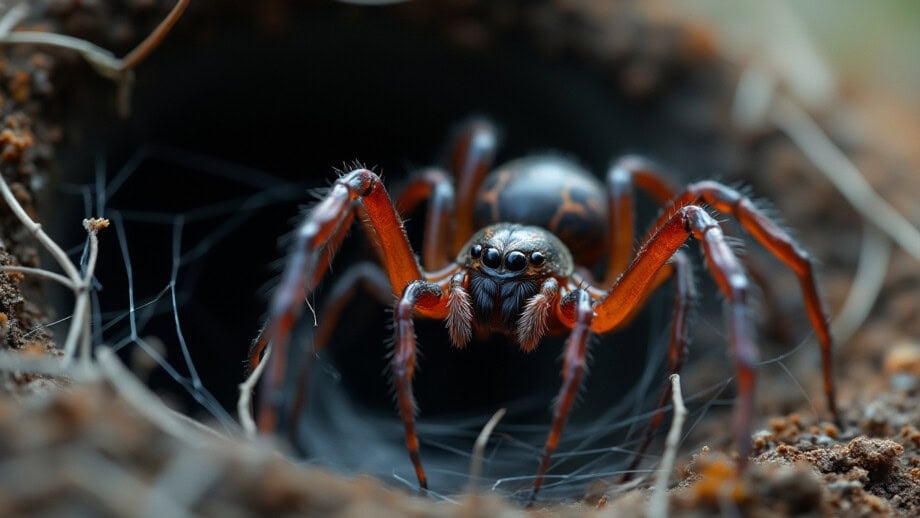How to Get Rid of Spiders: Inside and Outside the House

Many people have a very low tolerance level for any sort of creepy crawly in the house. Here’s how to get rid of spiders fast using organic and natural control techniques.
Some 30,000 species of spiders occur throughout the world. They have eight legs and two body segments.
For the most part, they are considered to be beneficial because they feed primarily on insects and other spiders.
At times they become a nuisance by finding their way inside your house. This typically occurs in the early fall when cooler temperatures force them to seek shelter.
Read on to learn exactly how to get rid of spiders, both inside your house and outside in the yard.
The 3 Most Common Spiders in the United States
Almost all spiders are harmless and usually remain hidden. They do not seek out and bite humans.
In fact, most cannot penetrate our skin with their fangs. A few are considered venomous to humans and care must be taken to avoid being bitten and needing medical attention.
Here are the three most common types of spiders you’ll come across in the US:
Black Widow (Latrodectus spp.)
Black widow spider adults have shiny black bodies (9/16 inch long) with a distinctive red or red-orange shaped hourglass pattern on the underside of the abdomen.
They are not aggressive and often found in dark, undisturbed areas including window wells, crawl spaces, corners of garages, and old rodent burrows. Their bite is rarely fatal.

Brown Recluse (Loxoceles reclusa)
Pale brown or buckskin colored, these venomous brown recluse spiders (1/3 inch long) have long, dark brown legs and a violin shaped darker marking on the top of the body near the head.
They are not aggressive and live within a loose web in dark corners of buildings. Their bite is painful, often leaving an ulcerous wound, but is rarely fatal.

Hobo (Tegenaria agrestis)
Originally from Europe, hobo spiders ended up in Seattle, Washington sometime before the 1930’s. Since then they have slowly expanded throughout the Northwestern United States and Western Canada.
Adults (1/4 inch long) are brown in color and have a chevron pattern on their abdomen. They live in a funnel web and are often found between bricks, in crawl spaces, around out buildings, and under wood. More aggressive than most, their bite is similar to that of the brown recluse and is rarely fatal.
There are a large number of non-poisonous spiders across North America that are similar in description to the hobo. As a result, many other species should be suspected before even considering the hobo spider as a possibility.
Life Cycle of a Spider
The life-cycle varies greatly depending upon species. In most cases, females reproduce by laying eggs in a silken egg sac. The egg sac is either carried around or hidden in the web.
Tiny, newly hatched spiders emerge 2-3 weeks later. Most mature to adults in about one year.
Several species live 1-2 seasons, but the females of a few species may live 5-20 years. Males and females live separately and only come together to mate.
Where Do Spiders Like Living?
Most spiders prefer to live outside, but you may come across a few that have made their way indoors in search of food or shelter.
When indoors, they like to live in dark, quiet areas such as basements, crawl spaces, attics, and garages. These areas offer protection from the weather and make great homes for web-building and hunting.
Whether you have a spider infestation in your home or garden, there are ways to get rid of them effectively.
The methods we can use to get rid of spiders varies depending on where the spiders are in your home. Meaning we’ll need to use different methods when they’re indoor vs outdoors.
Let’s look at each of them:
How to Get Rid of Spiders in Your House (Indoor Spider Control)
Here are the top ways to get rid of spiders in your house or apartment:
Keep a Tidy Home or Apartment
Keep your home clean on a regular basis. Don’t forget to vacuum your ceilings, furniture, and all of the corners in your home. When you keep your house clean, it’s harder for spiders to find places to hide that let them stay there.
Remove Webs
Inside the house, spiders and their webs can be eliminated by using a broom or vacuum cleaner.
To get rid of spider webs around your house, use a vacuum with a hose attachment. Do this as soon as you notice one in or around your house.
Clean up Leftovers
As soon as dinner is over, tidy up immediately.
Pests like ants and beetles are attracted to leftover food, crumbs, and other kitchen messes. In turn, these pests attract the spiders who eat them.
Regularly wipe down your counters and tables, and wash all of your dirty dishes right away.
Remove Clutter
Spiders can hide in cluttered areas. Remove as much clutter from your home as you can while keeping this in mind. Remove old magazines and newspapers, cardboard boxes, and clothing piles.
Keep boxes, old equipment and other items neatly stored on shelves, particularly in garages and basements. Clean up and dispose of trash, debris, old equipment, etc.
Install Screens
Install screens to protect against insects if you leave your doors and windows open during the day. Maintain them every year to keep the screens free of holes.
Repair screens and maintain the weather-stripping around doors and windows.
Improve Your Storage
Store your belongings in airtight plastic containers as opposed to cardboard boxes.
Not only will this keep spiders from hiding inside the boxes, but it will also protect your things from damage from dust and moisture.
Set Spider Traps
When strategically placed in high-traffic areas, sticky glue traps designed to catch and kill spiders can be quite effective.
Home and garden stores sell spider traps that you can buy right off the shelf. Crawling insect traps placed into tight corners will capture many crawling pests.
Keep them away from children and pets, and frequently inspect and replace them.
Make a DIY Spider Repellent
There are a variety of home remedies to get rid of spiders without the use of harmful pesticides. One of the most effective remedy comes from peppermint oil. Peppermint oil repels spiders because of its potent scent.
The best way to use essential oils is to add 15 to 20 drops of peppermint oil into a spray bottle filled with water and spray the mixture in areas where spider activity has been observed. Repeat often.
Other natural strong scents that spiders are repelled by include eucalyptus oil, citronella, horse chestnut, lavender, tea tree, cinnamon, citrus, cedar, marigold, lemon, and vanilla. You can use any of them in the same manner as peppermint oil.
Use Vinegar
Vinegar is a great natural spider repellant if you want to get rid of spiders without killing them or using pesticides.
To repel spiders, fill a spray bottle with half white vinegar and half water and spray the liquid into the corners of your home or bedroom. Use this natural spider repellent again every few days.
Use Insecticides
Store-bought insecticides and spray treatments are intended to be applied beneath furniture, along baseboards, and in the corners of your house.
These pesticides create a barrier that keeps spiders away or kills them. When dealing with severe spider infestations, they can be useful.
It’s important to use them cautiously and to read all label instructions because many of them include chemicals or toxins that are dangerous for children and animals.
Spray Orange Guard, made from citrus peel extract, to kill on contact. Approved for organic use, Orange Guard is a broad spectrum insect killer that’s safe to use indoors and out. Repeat applications may be necessary.
Use a Spider Catcher
Invest in a spider catcher if you like to remove spiders from your home without killing them. A spider catcher is a hand-operated wand meant to take up spiders in delicate, flexible threads and secure them until they may be released outside.
The spider catcher will work best when used with other home remedies, such as peppermint essential oil and vinegar.
How to Get Rid of Spiders Outside (Outdoor Spider Control)
Consider whether you actually need to kill the spiders before taking action to eliminate them from your garden or yard.
Spiders can prevent harmful insects from ruining your landscape by eating insects and other pests. In fact, a strong spider population can make other pest management measures less necessary.
The majority of spiders are not harmful to humans, thus it is typically possible to live in harmony with them.
If you really need to get rid of the spiders, here are a few options:
Use Essential Oils
Essential oils can be just as useful outside as they are inside. Use a few drops of an essential oil, such as peppermint, and apply it about the car, garage, and outside areas that need it.
Seal Holes and Entry Points
Caulk and seal gaps and cracks around your doors and windows, and cover any entry points in your siding or vents.
Apply Tanglefoot Pest Barrier to incoming pipes and door jambs to intercept home invaders.
Turn Off Outdoor Lights
Outdoor lights can attract insects such as moths, which in turn will attract spiders. So make it a habit of turning off outdoor lights.
Clean up Landscaping Elements
Trim the shrubs, trees, and bushes around your property so that they are several feet away from the siding.
Remove plants from your home’s perimeter. Consider moving shrubs, trees, and other plants farther away from your home if your spider infestation is severe.
When vegetation grows too close to your home, spiders can come inside looking for a new home.
Break Up Webs
Breaking apart spider webs will not harm or kill spiders, but it will cause them to relocate. When you find spider webs on your front porch or in your garden, use a broom or gloved hand to carefully remove them.
Remove Hiding Places Outdoors
Get rid of anything that provides spiders with a cool, dark place to hide, including rock piles, compost heaps, and brush piles.
Eliminating clutter from your home’s inside and exterior will help in preventing a spider infestation.
Apply Diatomaceous Earth
Apply food-grade Diatomaceous Earth for long-lasting protection. Made up of tiny fossilized aquatic organisms, that look like broken glass under the microscope, DE kills by scoring an insect’s outer layer as it crawls over the fine powder. Contains NO toxic poisons!
Use Insecticide Sprays
Least-toxic botanical insecticides should be used as a last resort. Derived from plants which have insecticidal properties, these natural pesticides have fewer harmful side effects than synthetic chemicals and break down more quickly in the environment.
Use insecticide sprays designed for spiders that you get from a store around your garden, yard, sheds, and deck.
These sprays can be useful for treating spider infestations because they kill spiders instantly upon contact. Use sprays with caution, wear protective clothes, and follow all label warnings.
For larger areas and crawl spaces consider using Doktor Doom Foggers. Made with natural pyrethrum, they provide fast re-entry times with no long-lasting odors.


















